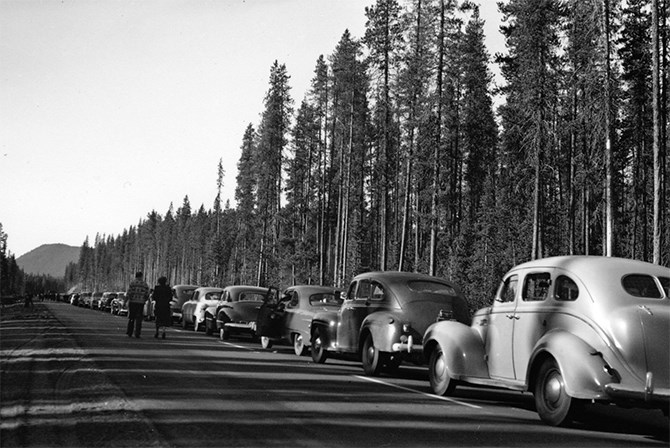
Vehicles line up at Allison Pass on the newly constructed Hope Princeton Highway for opening ceremonies on Nov. 2, 1949.
Image Credit: SUBMITTED/ Penticton Museum and Archives
November 10, 2019 - 7:00 AM
It was a Penticton dream for decades, but on Nov. 2, 70 years ago, the dream of a highway link to the coast became a reality for Okanagan residents in general, and Penticton residents in particular.
As far back as Nov. 29, 1916, a meeting of the Penticton Board of Trade formed a special committee to engage in soliciting support for a highway through the southern mountains of British Columbia.
Years prior to that, the route had begun as a series of old Indian trails that were followed by Hudson Bay Company employees and the region’s first settlers.
The Hope-Princeton carried a final price tag of $12 million dollars when opening ceremonies got underway at the Allison Pass summit on Nov. 2, 1949.
In his book “The Coast Connection,” R.G. Harvey called the opening of the highway “a milestone in the development of the British Columbia interior.”
The opening of the Hope-Princeton resulted in an increasing need for better roads in the Okanagan as tourists from the coast and freight traffic began picking up.
Then premier William (W.A.C) Bennett "ensured a steady but prudent level of improvements on Okanagan highways between 1947 and 1967, spending $5 million on the 39 mile stretch of highway,” Harvey wrote.
Not even a decade later, the ferry connecting Westbank with Kelowna across Okanagan Lake was replaced by the floating bridge, in 1958.
It’s effect on the Okanagan Valley economy was almost immediate, Penticton historian Randy Manuel says.
“It was the death knell for the Kettle Valley Railway. People had the option of a six hour road trip, given the state of the highway and vehicles of the day, versus 10 to 11 hours by rail,” he says.
Manuel says passenger rail traffic really dropped off in the months following the opening of the Hope - Princeton Highway. Freight also became easier and more efficient to ship by road, which allowed trucks to go depot-to-depot rather than offloading at a railway for transfer to a final destination.
The average number of passengers dropped 60 per cent between 1949 and 1950 on the Penticton to Vancouver run.
Manuel says the road’s opening also coincided with an increase in tourism in the valley, as Lower Mainlanders could now reach the Okanagan Valley and still get something out of a weekend.
The road effectively knocked 100 miles off the previous closest route from the coast to the Okanagan.
“Before the highway opened, it was a circuitous trip to the Okanagan via Spence’s Bridge, Merritt to Aspen Grove down to Princeton and on to the Okanagan. If that route was closed, vehicles had to drive up through Ashcroft to Kamloops, a 14 hour trip,” Manuel says.
The reduced importance of the railway also meant the end of an era for Penticton as the dominant community in the Okanagan. With the valley no longer dependent on rail traffic as the most efficient means of transportation, Penticton’s growth slowed over the following decades while Kelowna grew.
In 1951 Penticton had a population of 10,548, Kelowna 8,517, and Vernon, 7,822. By the mid 1960s Kelowna had overtaken Penticton as the valley’s most populous city, it's growth accelerating even more when the Coquihalla Connector opened in 1990.
In a July, 1998 interview, Ted Swales, son of the owner of Kaleden Esso located six kilometres south of Penticton, recounted the story of how his family’s business changed overnight when the Hope Princeton Highway opened on Nov. 2, 1949.
“Thousands of Lower Mainlanders descended upon the Okanagan overnight, overfilling accommodations in the valley and creating traffic of an immensity the locals had never seen before,” Ted Swales said.
His father’s service station was open until 2 in the morning, pumping gas for tourists, some of whom drove as far south as Tonasket, Washington, to find a place to sleep that weekend.
The 83 mile stretch of highway not only linked Hope and Princeton, it was also part of a series of road construction efforts to build a southern link - now Highway 3 - connecting the coast to the Alberta border.
To contact a reporter for this story, email Steve Arstad or call 250-488-3065 or email the editor. You can also submit photos, videos or news tips to tips@infonews.ca and be entered to win a monthly prize draw.
We welcome your comments and opinions on our stories but play nice. We won't censor or delete comments unless they contain off-topic statements or links, unnecessary vulgarity, false facts, spam or obviously fake profiles. If you have any concerns about what you see in comments, email the editor in the link above.
News from © iNFOnews, 2019